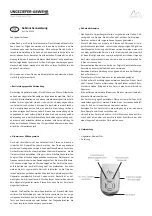
•
Analog Comparison Event
•
Change Detection Event
In addition, a counter’s Internal Output, Gate or Source can be routed to a different counter’s
Aux. A counter’s own gate can also be routed to its Aux input.
Some of these options may not be available in some driver software. Refer to the "Device
Routing in MAX" topic in the
NI-DAQmx Help
or the
LabVIEW Help
for more information
about available routing options.
Counter n A, Counter n B, and Counter n Z Signals
Counter
n
B can control the direction of counting in edge counting applications. Use the A, B,
and Z inputs to each counter when measuring quadrature encoders or measuring two pulse
encoders.
Routing Signals to A, B, and Z Counter Inputs
Each counter has independent input selectors for each of the A, B, and Z inputs. Any of the
following signals can be routed to each input:
•
Any PFI terminal
•
Analog Comparison Event
Routing Counter n Z Signal to an Output Terminal
You can route Counter
n
Z out to any PFI terminal.
Counter n Up_Down Signal
Counter
n
Up_Down is another name for the Counter
n
B signal.
Counter n HW Arm Signal
The Counter
n
HW Arm signal enables a counter to begin an input or output function.
To begin any counter input or output function, you must first enable, or arm, the counter. In
some applications, such as a buffered edge count, the counter begins counting when it is
armed. In other applications, such as single pulse-width measurement, the counter begins
waiting for the Gate signal when it is armed. Counter output operations can use the arm signal
in addition to a start trigger.
Software can arm a counter or configure counters to be armed on a hardware signal. Software
calls this hardware signal the Arm Start Trigger. Internally, software routes the Arm Start
Trigger to the Counter
n
HW Arm input of the counter.
Routing Signals to Counter n HW Arm Input
Any of the following signals can be routed to the Counter n HW Arm input:
•
Any PFI terminal
•
AI Reference Trigger
•
AI Start Trigger
98
|
ni.com
|
NI cRIO-905x User Manual



































